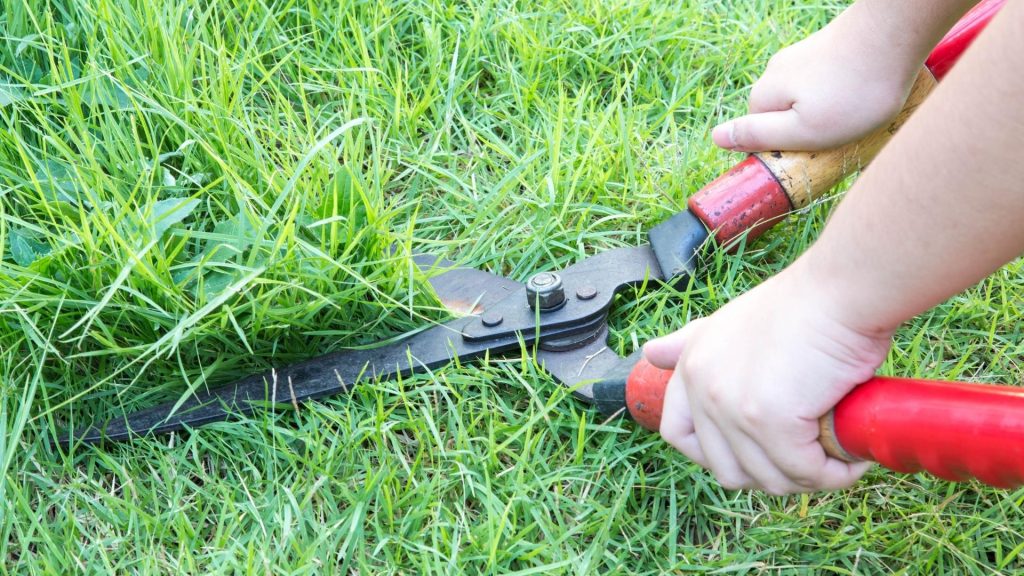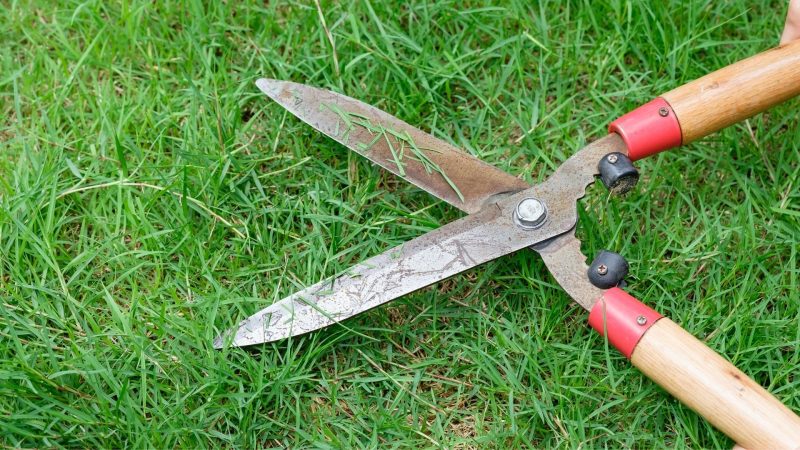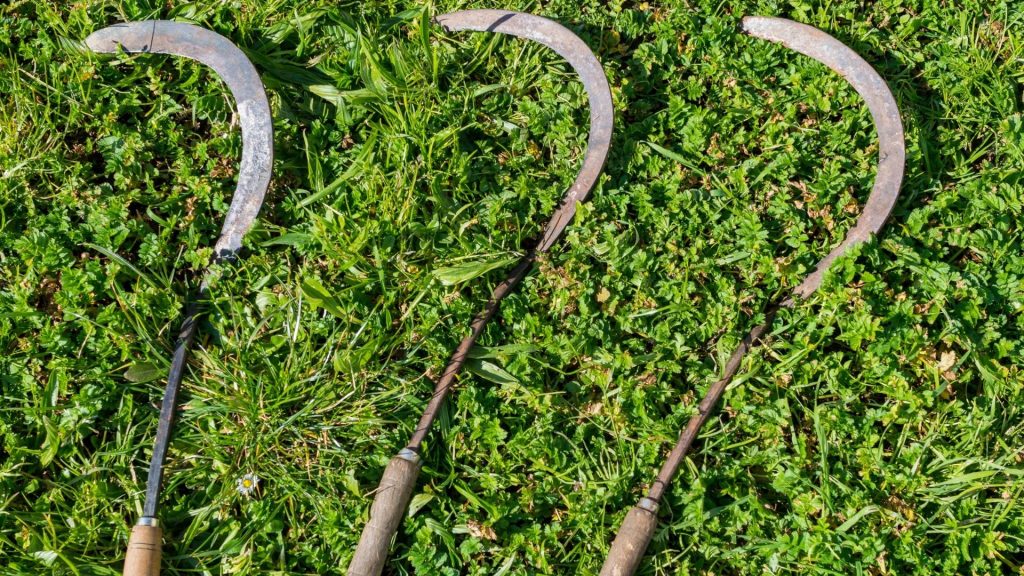Maintaining a lawn can be challenging, especially if you have been out of town for a long time and the grass becomes extremely long. Whether you like it or not, you should cut the tall grass as soon as possible. Nonetheless, you should always know which tools to use.
So, how do you cut extremely long grass? To cut extremely long grass, it is recommended that you follow the one-third rule. This means that you should only cut 1/3 of the grass at a time and maintain the two-thirds before cutting them again. You should also use the proper agricultural tools or equipment. In some cases, it’s better to use hand tools than an expensive, heavy-duty lawn mower.
Don’t assume that a lawn mower can always do the job better than hand tools. First of all, this machine can cause injuries if not used properly. Also, wet grass causes clogging and can damage your mower if water and gas are mixed. If you prefer using hand tools, this complete guide has everything you should know.
What Happens if Your Lawn Gets Too Long?

Sometimes, you don’t have time to mow your lawn because you’re very busy with other things. During summer, the heat can become intolerable, so you prefer taking a nap. But whatever reason you have for ignoring your lawn, having very long grass on your lawn has some negative effects. Here are some of them:
1. Your lawn will look ugly.
Having extremely long grass makes your lawn ugly and unattractive because the height of the grass will be uneven. The long grass also allows it to get to the seed. Because you did not cut them, most of the grass blades will look more like weeds than grass. Also, many areas have strict laws against no-mowing of lawns.
2. Grass will become unhealthy.
If the height or length of your grass is much longer than it should be, the health of your lawn will be affected. Aside from weeds, there will be some brown and dying patches that can attract pests such as grubs, armyworms, and sod webworms (or grass moths). Hence, they can lead to lawn stress and fungi grass diseases.
3. Excessive grass clippings issues.
Excessive grass clippings don’t only hide the beauty of your lawn; they also block sunlight and can prevent grass growth. Just like any kind of plant, lack of sunlight makes grass susceptible to disease. The extra grass clippings will also settle on your lawn and can also kill healthy grass. Remember, anything excessive is bad.
4. Mowing extremely tall grasses are difficult.
Using a lawn mower in cutting tall grass is also very difficult, even if you increase the blade height. Forcing your mower to cut overgrown grass instantly may cause damage to your machine, so you should cut them little by little. Moreover, because various weeds could also be present, some of them may be hard to dispose of.
5. Infrequent cutting of grass harms your lawn.
Having no regular schedule for cutting tall grass can also harm your lawn. If you allow grass to grow excessively and you can cut them at once, your lawn may be in shock because it will suddenly need fewer resources. The grassroots may eventually die if they will not recover on time, and you may need additional irrigation.
How Long Is Too Long to Cut Grass?
Cutting grass too short (or scalping) also causes problems. It reduces the leaf surface, causing the grass to rely only on its root in terms of food resources. This can lead to the weakening of the roots and weed invasion. Therefore, you should maintain a certain length of grass, depending on the type of grass your lawn has.
As mentioned earlier, cut only one-third (1/3) of the grass blade at a time and cut them again later. However, choosing the height of grass to cut means you need a height reference to follow. Below are some of the common grass species and the recommended height, when you already need to cut them:
Cool-Season Grasses
- Annual ryegrass: 2 1/4 – 3 inches
- Colonial bentgrass: 3/4 – 1 1/2 inches
- Hard fescue: 3 3/4 inches
- Kentucky bluegrass: 2 1/4 – 3 3/4 inches
- Perennial ryegrass: 2 1/4 – 3 3/4 inches
- Red fescue: 2 1/4 – 3 3/4 inches
- Tall fescue: 2 1/4 – 4 1/2 inches
Warm-Season Grasses
- Bermudagrass: 1 1/2 – 2 1/4 inches (for seeded); 3/4 – 1 1/2 inches (for hybrids)
- Buffalograss: 1 1/2 – 3 inches
- Kikuyu Grass: 1 1/2 – 2 1/4 inches
- Seashore paspalum: 1 1/8 – 2 1/4 inches
- St. Augustinegrass: 1 1/2 – 3 inches
- Zoysiagrass: 3/4 – 1 1/2 inches
How Often Should You Cut the Grass?

There’s no exact day or time on when you should cut the grass. The cutting frequency mainly depends on the type of grass, the season they are most active, cutting height, and their growth rate. To give you an idea, once a week during summer is fine. Just make sure you follow the one-third rule once they reach the height listed above.
Can You Cut Wet Grass?
You can cut wet grass on your lawn, but it depends on the tool you use. If you are using a lawn mower to cut wet grass, the cut will not be clean, even if your blades are sharp. The wet clippings will clog inside your mower, and some of them may drop into your lawn. If not properly raked, they will later kill your grass.
Using a lawn mower to cut wet grass also poses danger because you might fall while pushing the machine. Extremely wet grass also causes wheel ruts in your lawn, which can tear your grass. On the other hand, a scythe is an ideal tool for cutting wet grass. The moisture adds weight to the grass, making it easier to cut.
What Is the Best Tool for Cutting Long Grass?
Choosing the best tool depends on how tall the grass is. For extremely long grass, say 3 feet, you may want to use a sickle such as Zenport K310 Brush Clearing Sickle. This inexpensive hand tool has a 9-inch handle and a 9-inch carbon steel blade that’s so sharp and can also be used to cut bamboo.
If your grass is not that long, say about a foot only, a scythe is the best tool for you. A great example would be the SHANGYISM Weeding Scythe, Multi-Purpose Gardening Hand Scythe Tool, which is lightweight, ergonomic, and relatively cheap. With scythes, you also don’t need to bend your back from time to time.
There are portions on your lawn that cannot be trimmed properly, even with the use of a scythe or a lawn mower. This is when a grass shear can do the job. Manual grass shears such as Edward Tools Hand Grass Clipper Scissors have comfortable grip handles and sharp steel blades that can easily be resharpened.
Grass shears are ideal tools for cutting grass on the edge of your lawn that lawn mowers cannot reach. Here, you can easily cut grass to your desired height with less effort. They are also available in corded or battery-operated, and some models have an adjustable blade so you can choose your desired angle.
How to Use a Scythe?
A scythe is a hand tool that can be used for cutting long grass and is a great alternative to an expensive lawn mower. This agricultural tool has been used by small farmers for centuries and has been proven very effective. However, you need to be physically fit. Here are the steps on how to use a scythe properly:
Step 1: To avoid back pain, stand straight with your feet apart. You can slightly bend your knees but don’t bend forward. (The succeeding steps are for right-handed people. If you’re left-handed, do the opposite position.)
Step 2: Point the blade part to your left. Slowly twist your body, arms, and shoulders to the left.
Step 3: Push with your right hand and pull with your left hand. Always keep your arms and hands relaxed.
Step 4: To maximize the cutting of the grass, swing the scythe 180 degrees arc from right to left.
Step 5: Throughout the entire stroke, make sure the blade stays flat on the ground. It should also travel to the direction where the tip is pointing.
Step 6: To cut the next portion, lift the tool slightly to go back to the right and move one step forward.
Tips:
- For better results, add power to your cutting stroke by shifting your weight from right to left.
- To minimize arm work, reduce power when going back to the right.
- Make sure that the blades are properly sharpened. Otherwise, the grass will only be pushed down and will not be trimmed.
How to Use a Grass Shear?

A grass shear looks like giant scissors, except that the blades are usually perpendicular to the handle. Unlike pruning shears that are used for plants and small tree branches, this hand tool is ideal for spot or edge trimming in lawns. Their blades can be horizontal, vertical, or can be adjusted to a certain angle.
Vertical blades are ideal for cutting edges, while horizontal blades are for trimming grass to a specific height. Some of them have long handles, which are designed to be used in a standing position. However, shears with short handles tend to give a more flawless look. Here are the steps on how to use a shear:
Step 1: Sit upright and hold each side of the handles firmly with each hand. Wear gloves to avoid having hand blisters.
Step 2: Before cutting, make sure the horizontal blades are parallel to the ground.
Step 3: During the cutting, make sure the handles touch each other. This is to ensure that the blades can cut the grass properly.
Step 4: For better results, cut only a small area of grass at a time and move around your lawn instead of cutting the grass in separate areas.
How to Use a Sickle?

A sickle is an agricultural tool that has a curved blade and usually with a short handle. Just like a scythe, this is very effective in cutting extremely long grass. However, this time, you only need to use one hand to cut grass. Also, this is ideal for cutting the weeds on your lawn. Here is how to use a sickle to cut grass:
Step 1: Bend slightly (or sit) and hold a bundle of grass on its upper portion. In some cases, you don’t need to hold the grass.
Step 2: Using the other hand, swing the sickle on the height of grass you want to cut. Be careful not to hit your body or leg.
Step 3: For faster cutting, hold as many bundles of grass as possible.
Note: Using a sickle is more tiring and exhausting than using a scythe or a garden shear. Also, you may not be able to cut grass at a uniform height.
How Can I Cut My Grass Without a Machine?
If you don’t have a lawn mower, or you don’t want to use one, don’t worry. You can still cut your grass effectively and safely use an electric string trimmer, which is also called a weed eater. But if you prefer hand tools, you can use a grass shear, a scythe, or a sickle. Just don’t forget to wear safety gloves.
Is Scything Faster Than Mowing?
In the ideal world, mowing is without any doubt faster than scything. This is because an electric lawn mower cuts grass continuously, while manual cutting using a scythe has some stops. But in the real world, using a scythe to cut grass can be as fast as with the use of a lawn mower and can even be faster.
A physically-fit, experienced scythe user can cut grass fast and with a steady pace. On the other hand, a lawn mower can get stuck in the grass and will slow the process.
Cutting Extremely Long Grass | A Step by Step Guide
Step 1: Cut the top layer of the grass using a grass trimmer or sickle.
Step 2: Water your lawn just enough. This is to ensure that the grass can recover from the cut.
Step 3: After a few days or a week, do the second cutting. This time, you use a scythe. You can also use a lawn mower, as long as the grass is not wet.
Step 4: If you followed the 1/3 rule religiously, leave the clippings on your lawn.
Contrary to popular beliefs, grass clippings need not be removed from your lawn. Once they become decomposed, they can serve as soil fertilizers. Rake them off only if they are too long, but don’t throw them away because you can use them later as mulch. In doing so, you can save some money when buying fertilizers.
Tips on Treating an Overgrown Lawn
- Never mow wet grass; cut them with a scythe instead of using a lawn mower.
- Maintain a grass height of 2 ½-3 inches if the grass is growing fast. An overgrown lawn also attracts small rodents in the winter.
- Cut slightly shorter during the first and last cuttings of the year.
- Don’t cut the grass too short. Otherwise, there will be a weed invasion.
- Always make sure that your cutting blades are razor-sharp. Dull blades invite diseases to your grass.
- Stop cutting the grass only if it stops growing, which usually happens every fall season (or October).
- Summer causes stress to your lawn, so increase the cutting height by about an inch during this season.
- If possible, change cutting directions frequently. This helps prevent grass from scalping, thus improving its growth.
- Don’t water your lawn every day for a few minutes. Instead, do the watering every week for about an hour.
How to Prevent Your Lawn From Becoming Overgrown?

To prevent your lawn from becoming overgrown, you can do the following tips:
- Know your grass so you will have an idea when you should cut them.
- Have a regular schedule of maintaining your lawn
- If you will be out of town, cut the grass the day before you leave.
- Keep your lawn healthy by adding fertilizer and compost.
Summary
Cutting extremely long grass on your lawn is like cutting your hair short. You don’t just start cutting the grass anywhere or in any way you like. The key here is to follow the recommended one-third rule. Understanding the different gardening tools is also very important since you cannot always depend on lawn mowers.
List of Sources
How Much, When, and How Often to Mow